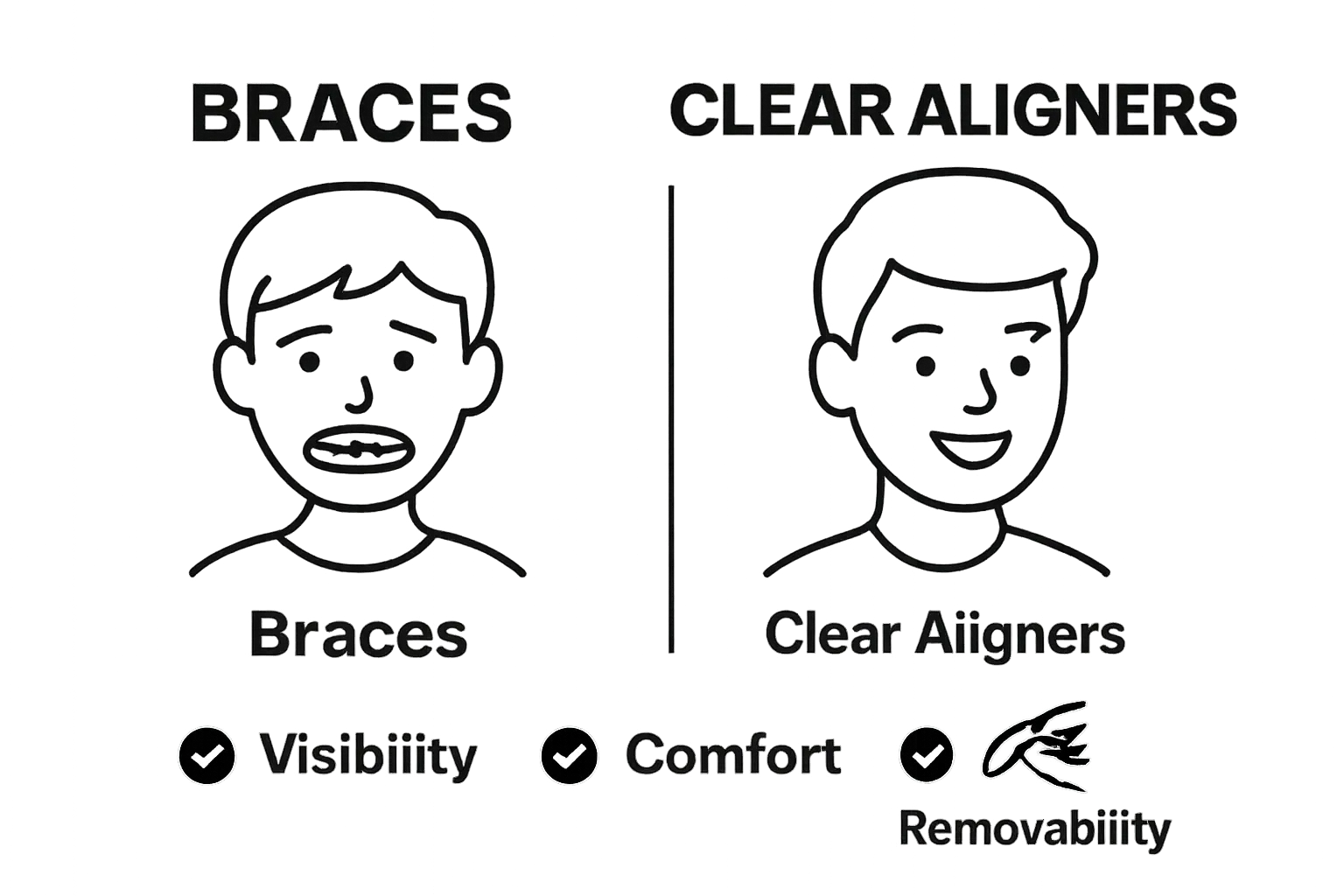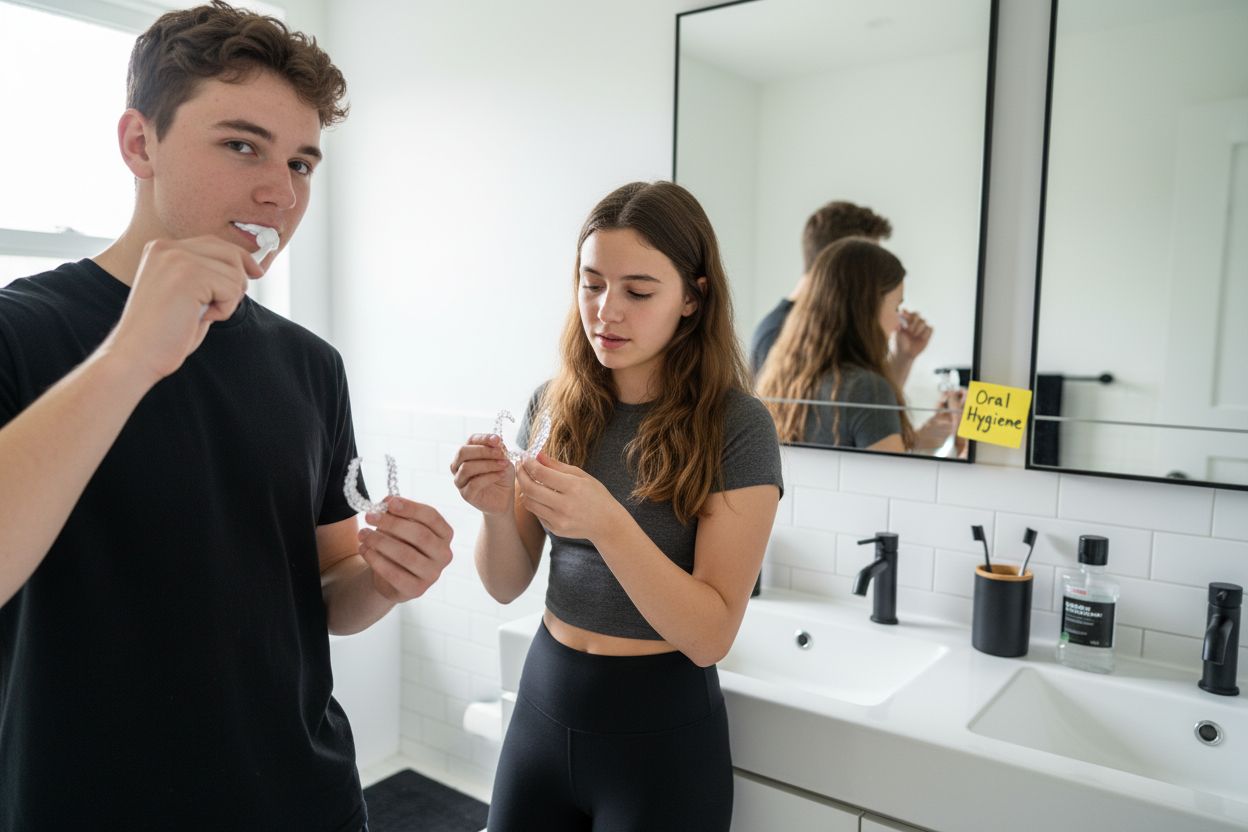Understanding Invisible Braces for Teens: A Comprehensive Guide
October 6, 2025
Understanding Invisible Braces for Teens: A Comprehensive Guide
Invisible braces are changing the way people straighten their teeth and making metal wires look like a thing of the past. Here is the wild part. Most patients only need to wear invisible aligners for six to eighteen months to see full results and they can take them out whenever they eat or brush their teeth. This means teens and adults get a more comfortable smile and keep their confidence at school or work without anyone even noticing.
Table of Contents
- What Are Invisible Braces And How Do They Work?
- The Importance Of Choosing Invisible Braces For Teens
- Understanding The Benefits Of Clear Aligners For Young Smiles
- Key Concepts Of Orthodontics And Clear Aligners
- Real-World Experiences: Teens And Their Journey With Invisible Braces
Quick Summary
| Takeaway | Explanation |
|---|---|
| Invisible braces provide aesthetic comfort. | Their transparent design minimizes visibility, boosting self-esteem during treatment. |
| Treatment duration varies by complexity. | Patients typically wear aligners for 6 to 18 months, based on individual needs. |
| Removable aligners promote better hygiene. | Patients can easily clean their teeth without obstruction, reducing dental issues during treatment. |
| Customized treatment plans enhance effectiveness. | Advanced technology allows for personalized aligner configurations for precise tooth movement. |
| Psychological benefits support social confidence. | Teens often feel less anxious and more at ease without visible braces during social interactions. |
What Are Invisible Braces and How Do They Work?
Invisible braces represent a revolutionary approach to orthodontic treatment that transforms how teenagers and adults correct dental alignment. Unlike traditional metal braces, these innovative devices offer a nearly transparent method of straightening teeth without the conspicuous appearance of wire and bracket systems.
The Science Behind Clear Aligners
Invisible braces, also known as clear aligners, are custom-manufactured plastic trays designed to gradually shift teeth into their ideal positions. According to the NHS orthodontic guidance, these aligners work through precise, calculated movements that apply gentle consistent pressure to specific teeth.
The technological process involves creating a digital 3D model of a patient’s mouth, which allows orthodontists to map out the entire treatment progression. Each set of aligners is meticulously crafted to represent a different stage of tooth movement, with patients typically changing to a new aligner every one to two weeks.
Key Characteristics of Invisible Braces
Invisible braces offer several distinctive advantages that make them particularly attractive for teenagers and young adults:

- Aesthetic Appeal: Transparent design makes them nearly undetectable during daily interactions
- Removability: Patients can take them out while eating, drinking, or performing oral hygiene
- Comfort: Smooth plastic eliminates the potential for metal wire irritation
- Predictable Results: Advanced digital modeling allows for precise treatment planning
The treatment typically ranges from six to eighteen months, depending on individual dental complexity. Patients must wear their aligners for 20 to 22 hours daily to ensure optimal results, removing them only for meals, dental hygiene, and special occasions.
By combining cutting-edge digital technology with sophisticated material science, invisible braces provide a modern solution to traditional orthodontic challenges, giving patients a more comfortable and discreet path to achieving their ideal smile.
The table below summarizes key features and benefits of invisible braces for teens, offering a clear overview of what makes them a popular choice.
| Feature/Benefit | Description |
|---|---|
| Aesthetic Appeal | Transparent and discreet, rarely noticed in daily interactions |
| Removability | Can be removed for meals, hygiene, and special occasions |
| Comfort | Smooth plastic reduces gum and cheek irritation |
| Advanced Technology | Digital 3D modeling enables precise, personalized treatment planning |
| Hygiene | Allows thorough brushing and flossing without obstruction |
| Predictable Results | Sequential aligners and plans provide clarity on treatment progression |
| Lifestyle Compatibility | Minimal interference with sports, music, and social activities |
The Importance of Choosing Invisible Braces for Teens
Selecting the right orthodontic treatment during adolescence goes far beyond dental correction. For teenagers, invisible braces represent more than just a method to align teeth they offer a transformative experience that impacts psychological well-being, social confidence, and long-term oral health.
Psychological and Social Benefits
Teenage years are critical for emotional and social development, and traditional metal braces can often become a source of self-consciousness. Research from the American Journal of Orthodontics indicates that adolescents wearing visible orthodontic appliances frequently experience increased anxiety and reduced social interaction.
Invisible braces provide a discreet alternative that allows teenagers to maintain their self-esteem. The transparent design means they can smile, speak, and engage in social activities without feeling embarrassed about their orthodontic treatment. This psychological comfort can significantly reduce the potential negative emotional impacts associated with traditional braces.
Long-Term Health and Lifestyle Considerations
Beyond aesthetic advantages, invisible braces offer substantial practical benefits for teenage lifestyles:
- Sports Participation: No risk of metal brackets causing mouth injuries during physical activities
- Musical Instrument Playing: Easy removal eliminates interference with wind or brass instruments
- Dietary Flexibility: Removable aligners allow unrestricted eating without complex cleaning procedures
- Oral Hygiene Maintenance: Simple cleaning process compared to traditional braces
Moreover, the precision of digital treatment planning ensures more predictable outcomes. Teenagers can visualize their potential results before treatment begins, providing motivation and understanding of their orthodontic journey.
The ability to remove aligners temporarily also promotes better oral hygiene. Unlike fixed braces, teens can brush and floss normally, reducing the risk of dental complications during treatment. This flexibility encourages more consistent and thorough dental care habits that can persist well beyond orthodontic treatment.
Choosing invisible braces represents a comprehensive approach to teenage dental care that balances medical necessity with personal comfort and psychological well-being.
Understanding the Benefits of Clear Aligners for Young Smiles
Clear aligners represent a groundbreaking approach to orthodontic treatment that specifically addresses the unique dental development needs of young patients. These innovative devices offer more than cosmetic improvement, providing comprehensive dental health solutions tailored to adolescent growth patterns.
Precision and Personalized Treatment
According to the American Association of Orthodontists, clear aligners utilize advanced digital mapping technology that creates a highly personalized treatment strategy. Each aligner is meticulously designed to apply targeted pressure, guiding teeth into their optimal positions with remarkable accuracy. This precision ensures that young patients receive treatment specifically calibrated to their individual dental anatomy.
The digital treatment planning process allows orthodontists to predict and visualize tooth movement with unprecedented detail.
Teenagers can actually see potential outcome simulations before beginning treatment, which provides motivation and transparency throughout their orthodontic journey.
Comprehensive Health and Development Benefits
Clear aligners offer significant advantages that extend beyond traditional orthodontic corrections:
- Developmental Support: Supports proper jaw alignment and bite formation during critical growth periods
- Minimal Intervention: Reduces potential dental trauma associated with more invasive treatments
- Comprehensive Monitoring: Enables continuous tracking of dental development
- Adaptive Treatment: Can be adjusted to accommodate ongoing facial growth
Unlike traditional braces, clear aligners allow for easier monitoring of dental development. The removable nature means orthodontists can regularly assess tooth movement and make precise adjustments, ensuring optimal results throughout adolescence.
The biomechanical approach of clear aligners considers not just tooth positioning, but the holistic development of a young patient’s oral structure. By applying gentle, consistent pressure, these devices support natural dental growth while correcting misalignments, providing a nuanced approach to orthodontic care that respects the complex biological processes of adolescent dental development.
Key Concepts of Orthodontics and Clear Aligners
Orthodontics represents a sophisticated medical discipline focused on diagnosing, preventing, and correcting misaligned teeth and jaw structures. Understanding the fundamental principles behind orthodontic treatments helps patients appreciate the complexity of achieving optimal dental alignment.
Biomechanical Foundations of Tooth Movement
According to the National Institutes of Health, orthodontic treatments fundamentally involve applying controlled, consistent pressure to gradually shift teeth into their desired positions. This process relies on the biological principle of bone remodeling, where strategic force creates microscopic changes in bone density and structure.
Clear aligners utilize sophisticated biomechanical principles to create precise tooth movements. By designing sequential plastic trays with incrementally adjusted configurations, orthodontists can predict and control dental repositioning with remarkable accuracy. Each aligner generates specific directional forces that stimulate cellular responses in the periodontal ligament, facilitating gradual and controlled tooth migration.
Essential Orthodontic Considerations
Successful orthodontic treatment encompasses multiple critical factors beyond mere mechanical movement:
- Biological Response: Understanding individual patient’s tissue regeneration capabilities
- Genetic Influences: Recognizing inherited dental structure variations
- Structural Complexity: Analyzing jaw alignment and bite relationships
- Growth Dynamics: Accounting for ongoing developmental changes
The technological advancement of clear aligners has revolutionized how orthodontists approach dental corrections. Unlike traditional braces, these innovative devices offer a more nuanced, patient-centered approach that considers individual anatomical variations and growth patterns.
By integrating digital imaging, computational modeling, and advanced material science, modern orthodontic treatments can now provide highly personalized solutions. Clear aligners represent a sophisticated intersection of medical expertise, technological innovation, and patient comfort, transforming the landscape of dental correction strategies.
Real-World Experiences: Teens and Their Journey with Invisible Braces
Navigating orthodontic treatment during adolescence is a deeply personal experience that extends far beyond simple dental correction. Invisible braces have transformed how teenagers perceive and undergo orthodontic interventions, offering a more empowering and confidence-building approach to dental health.
Emotional and Social Transformation
Research from adolescent psychology studies reveals that invisible braces significantly impact teenage self-perception and social interactions. Unlike traditional metal braces, clear aligners provide a sense of control and discretion that helps teens maintain their social confidence during critical developmental years.
Teenagers report feeling more comfortable in social settings, participating more actively in conversations, and experiencing reduced anxiety about their appearance. The ability to remove aligners for special events, photographs, or social gatherings means that orthodontic treatment no longer feels like a constant, visible reminder of dental correction.
Practical Challenges and Adaptation
Transitioning to invisible braces involves several unique considerations for teenagers:
- Responsibility Management: Learning to consistently wear aligners for recommended hours
- Oral Hygiene Discipline: Developing more rigorous dental care routines
- Time Management: Balancing treatment requirements with school and extracurricular activities
- Social Navigation: Communicating with peers about their orthodontic treatment
Successful adaptation requires support from family and orthodontic professionals. Many teenagers find that the initial learning curve quickly becomes a manageable part of their daily routine. The removable nature of clear aligners actually encourages more proactive oral hygiene practices, as teens must clean their teeth before reinserting aligners.

Moreover, the digital tracking and predictable treatment progression provide teenagers with a sense of engagement in their own healthcare journey. Seeing potential outcomes and understanding the step-by-step process transforms orthodontic treatment from a passive experience to an active, empowering personal development process.
Ready to See Your Teen Smile with Confidence?
Struggling to find an orthodontic solution that truly fits your teenager’s lifestyle and self-esteem? When research shows that visible braces can increase anxiety and limit social comfort, the need for a subtle and comfortable alternative is clear. This comprehensive guide highlighted how invisible braces provide a discreet way to support oral health, encourage responsibility, and boost confidence by using clear aligners and individualized digital plans.
Learn about our personalized approach at Glow Orthodontics

Give your teen the confidence and care they deserve. Explore how Glow Orthodontics specializes in invisible braces and Invisalign for teens and experience our supportive guidance every step of the way. Take action today to book a consultation or reach out through our contact page. Begin the journey to a glowing, healthy smile now.
Frequently Asked Questions
What are invisible braces and how do they work?
Invisible braces, or clear aligners, are custom-made plastic trays designed to gradually shift teeth into their correct positions. They apply gentle, consistent pressure to specific teeth, and patients typically change to a new aligner every one to two weeks during treatment.
What are the benefits of using invisible braces for teens?
Invisible braces offer aesthetic appeal, as they are nearly undetectable. They are removable, allowing for easier eating and oral hygiene. They are also more comfortable than traditional metal braces and provide predictable treatment results through advanced digital modeling.
How long does treatment with invisible braces typically take?
The treatment duration usually ranges from six to eighteen months, depending on individual dental complexity. Patients must wear their aligners for 20 to 22 hours a day for optimal results.
What are the main differences between invisible braces and traditional metal braces?
Invisible braces are discreet and removable, making them more comfortable for daily life compared to traditional metal braces, which can be cumbersome and visible. Additionally, clear aligners allow for easier dental hygiene maintenance since they can be removed while eating and brushing.
To help you compare orthodontic options for teens, the following table outlines the main differences between invisible braces and traditional metal braces.
| Feature | Invisible Braces (Clear Aligners) | Traditional Metal Braces |
|---|---|---|
| Visibility | Nearly invisible | Highly visible |
| Removability | Removable for eating, cleaning | Fixed to teeth |
| Comfort | Smooth plastic, less irritation | Metal wires and brackets may irritate |
| Oral Hygiene | Easy brushing and flossing | More challenging to clean around |
| Treatment Duration | 6-18 months (varies by case) | 18-24 months (varies by case) |
| Dietary Restrictions | Few to none | Many foods must be avoided |
| Social and Emotional Impact | Discreet, boosts confidence | May cause self-consciousness |